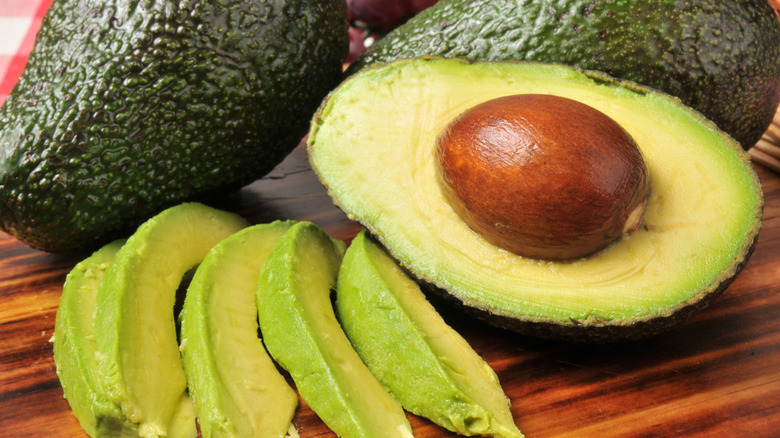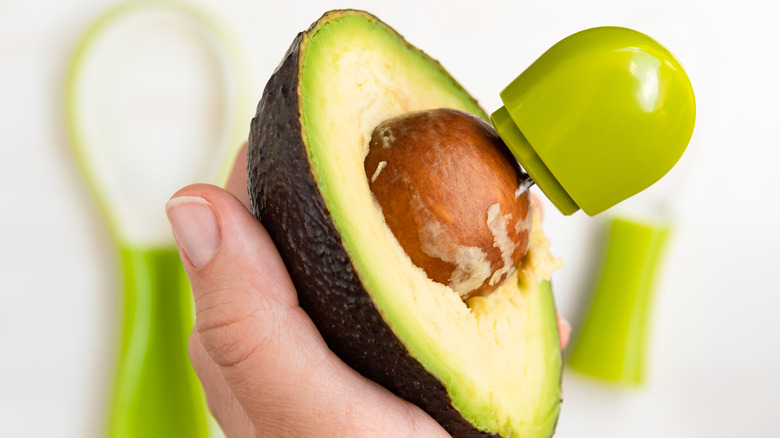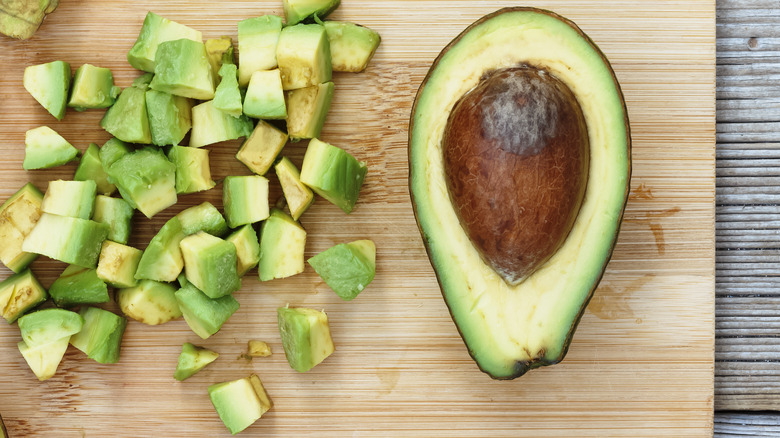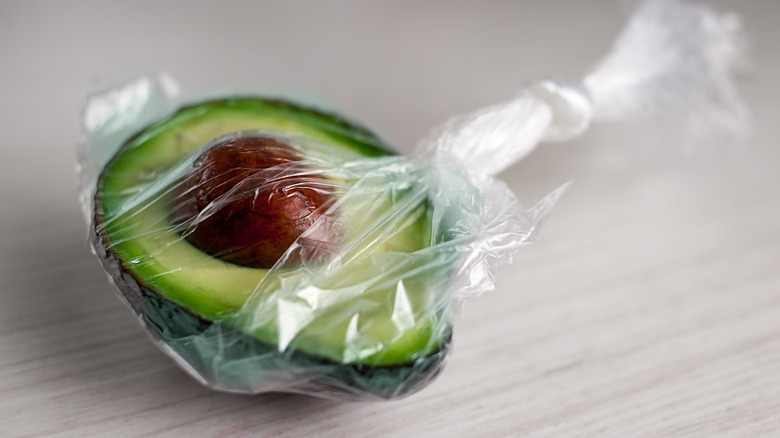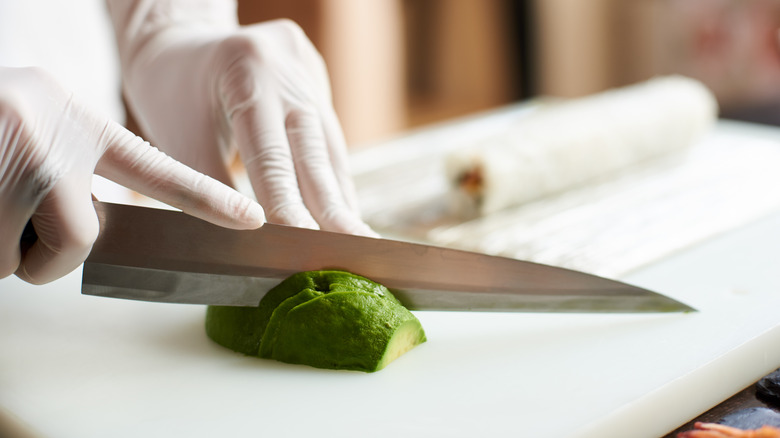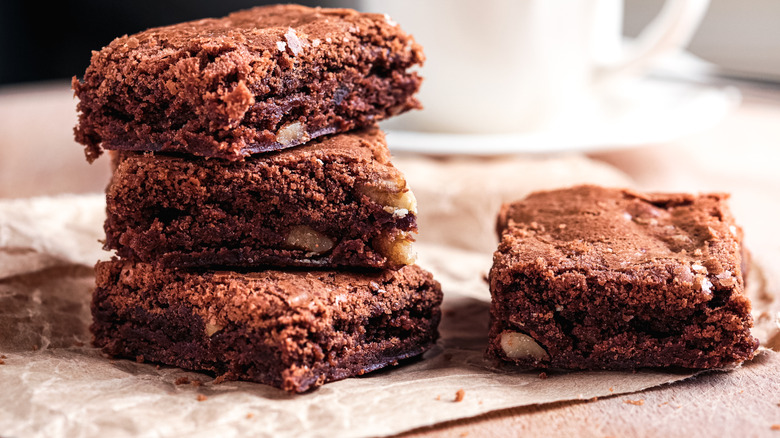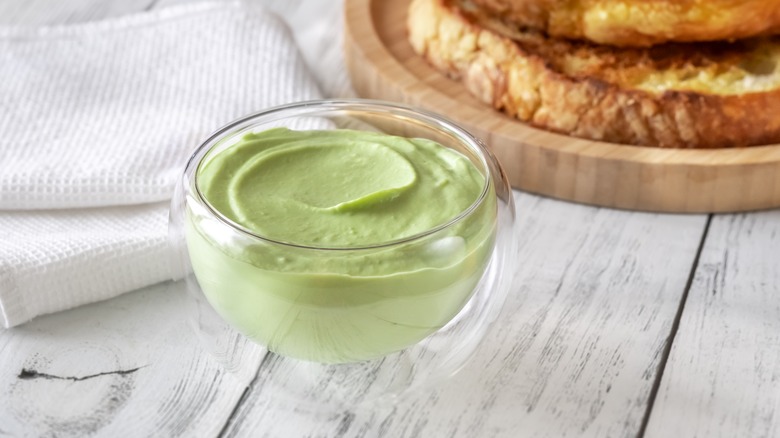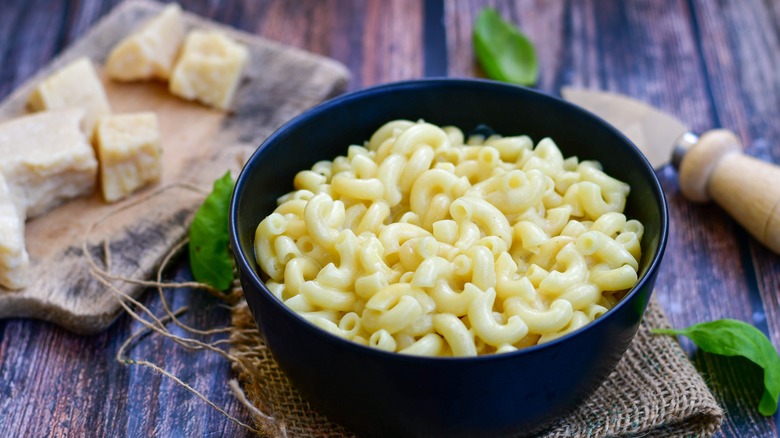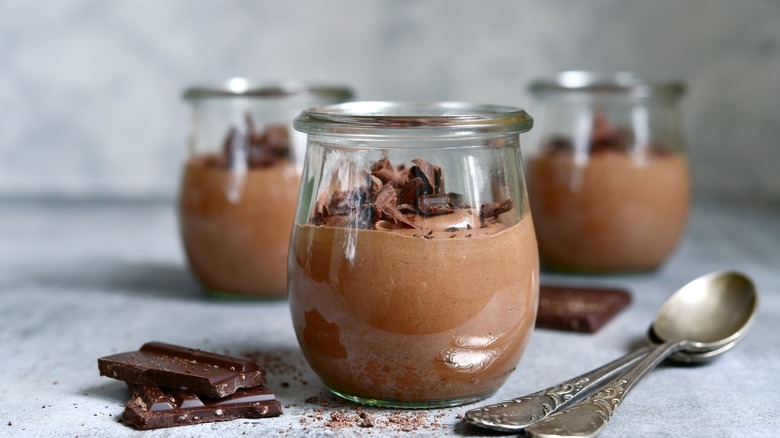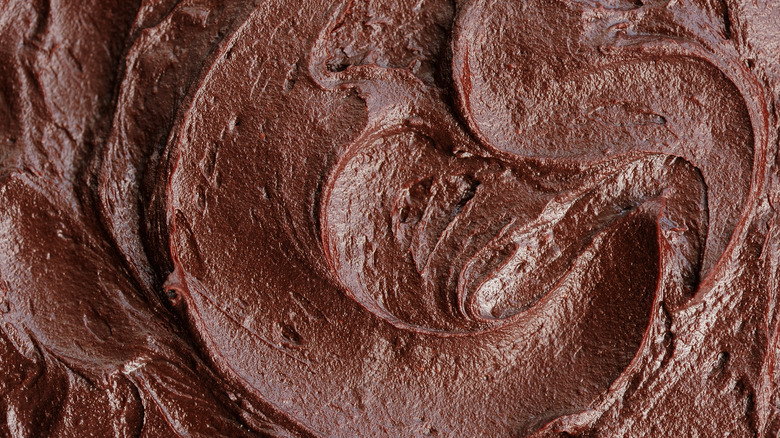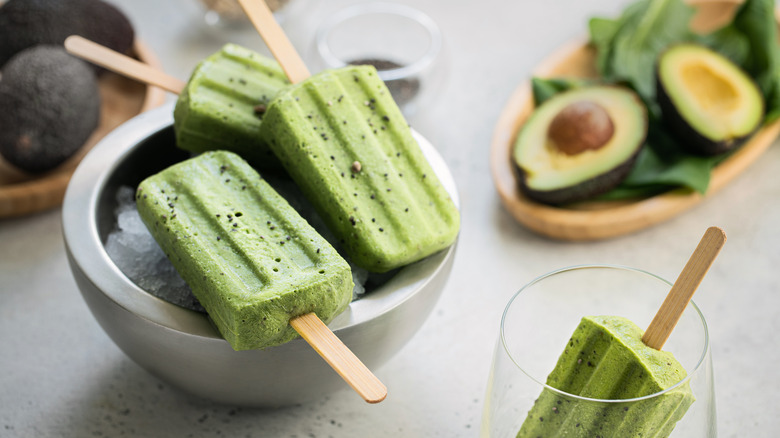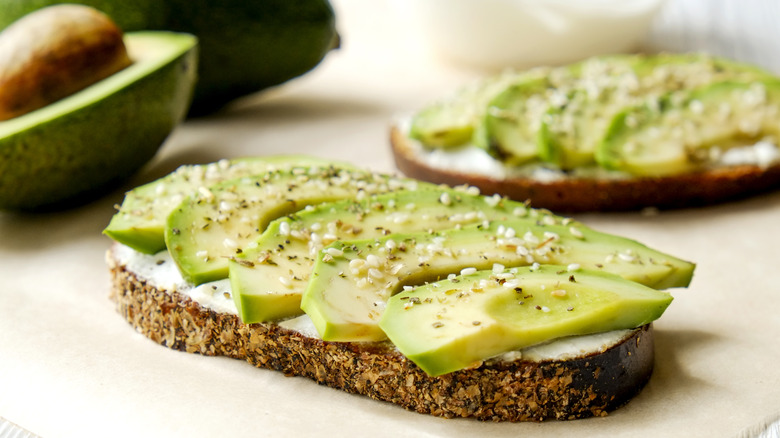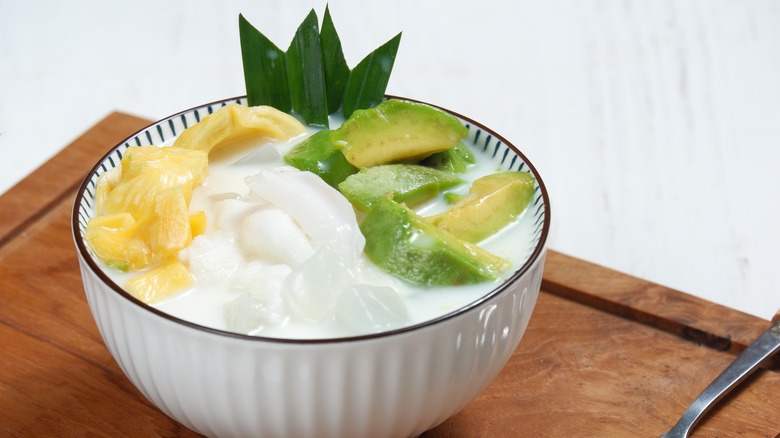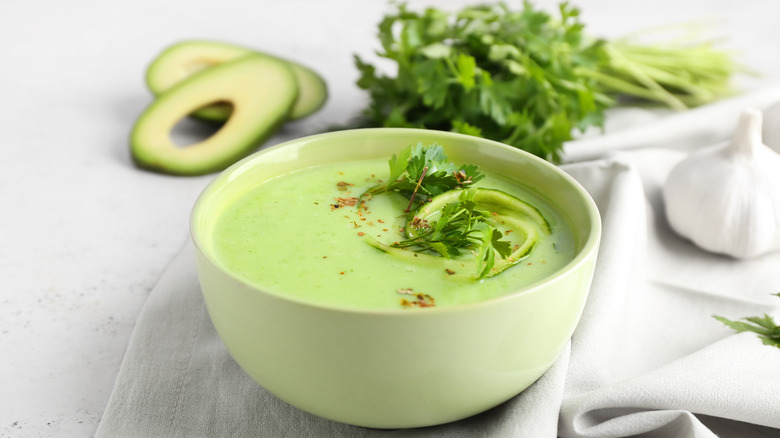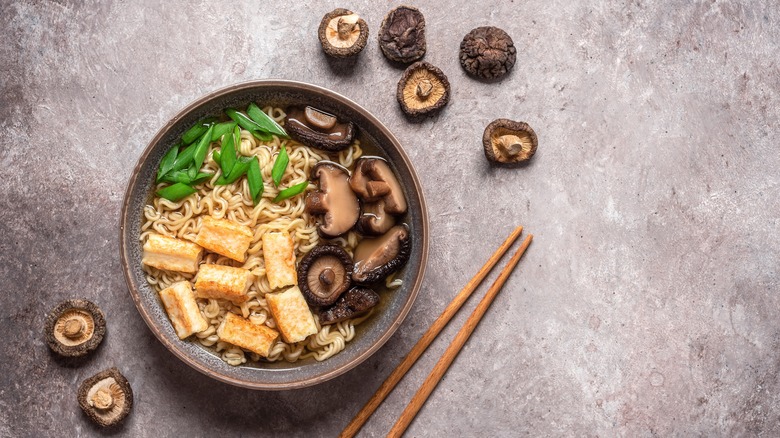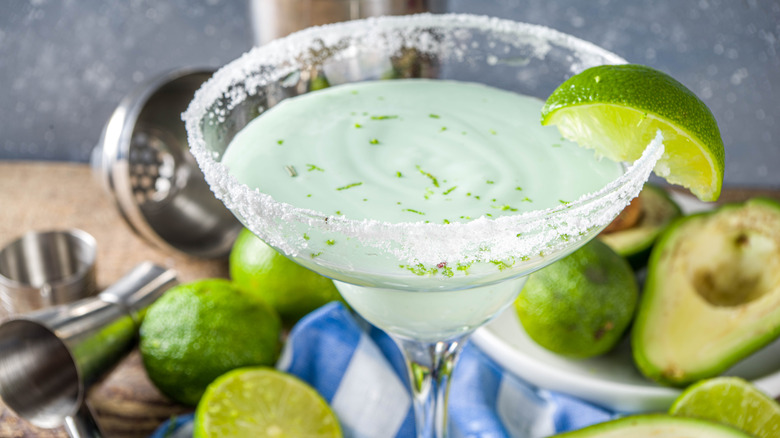15 Tips You Need When Cooking With Avocado
Avocado is a popular fruit, with guacamole and avocado toast as leaderboards among the dishes that use this ingredient. The soft, buttery texture and the unique flavor of the fruit (which actually seems more like a vegetable) has some dedicated fans, but also people who dislike it, proving, once more, that when it comes to food, it's all a matter of taste.
Avocado is a berry, according to Healthline. It is also incredibly healthy and nutritious, containing fiber, vitamin C, vitamin E, vitamin K, vitamins B2, B3, B5, and B6, folate, and copper. Avocado is native to Mexico and has been cultivated for over 5,000 years, (per Avocados from Mexico). The avocado was a vital nutrient source for the indigenous people of Central America, and they considered it possessed mythological powers. Today, it is cultivated in many parts of the world, from California to India, where it is mainly referred to as "butter fruit." Here are some useful tips for those who want to cook with avocado.
Remove the avocado pit safely
As avocado has become more popular during the past decade, so have avocado-related injuries. The most common of these is what emergency doctors call "avocado hand," meaning deep knife cuts to the fingers, wrists, and palms of the non-dominant hand. The avocado hand is generally caused by situations in which the knife slips or misses the pit as you try to remove it.
However, there are specific safe ways to remove an avocado pit and ensure that you won't fall victim to this kind of kitchen accident. For starters, use a butter knife to cut through your avocado, but ditch it when removing the pit. Use a spoon instead, as it has smooth edges and won't hurt you even if it slips. Next, scoop out the avocado pit using a smaller spoon with a pointier tip instead of a soup spoon. Place the spoon's edge under the pit and lift it out of the fruit. Another way to safely remove an avocado pit is to use your fingers. First, place your thumb on the back of the avocado and your index and pointer fingers on the sides of the pit. Then push with your thumb from the outside until it comes out.
Dice avocado using a cooling rack
One of the most attractive features of avocado, aside from the flavor, is the soft, creamy-like consistency. Unfortunately, it is also the aspect with the shortest shelf life, as avocados have that perfect consistency and color for a limited time, and you must use the fruit at the perfect moment. Slice it too early, and you will have a stone-like consistency, or too late, and you will get a mushy, indistinguishable mass instead of rectangular pieces. Even if you manage to get the right timing, it can prove tricky to dice your avocado perfectly for those dishes which rely on the aspect.
Fortunately, there is a convenient trick to dice your avocado fast and in perfectly cut rectangles. Instead of using a knife, use a cooling rack. First, take the pit out of your avocado, then gently press the halved fruit through a cooling rack, enjoying the resulting perfectly-shaped cubes. Toss them on top of toast, season, and you'll have an Instagram-ready breakfast.
Freeze your avocado
Nothing is worse than getting the right ripeness level for an avocado only to find that you can't use it entirely. As it's one of the fastest fruits to spoil, it's recommended that you only use the exact amount of avocado required by the recipe. But what do you do with the leftovers?
Freezing avocado is safe, efficient, and avoids food waste. Healthline advises freezing avocado halves, pieces, and the mashed and puréed fruit. If you choose to freeze halved or diced avocado, brush the flesh with lemon juice to keep it from browning, then wrap it as tightly as possible. Leave as little air as you can to prevent freezer burn. If you choose to freeze mashed or puréed avocado, place it in a container or resealable bag and press out the air. When you want to thaw your frozen avocado, take it out of the freezer and leave it in the fridge or on the counter. Frozen avocado has a softer consistency, so use it for spreads or smoothies.
Avoid contact with metal knives
Nobody wants an avocado that has turned brown. This situation occurs mainly when you only need half the fruit, and you're saving the other half. One of the most common mistakes when using avocado is cutting it with a knife unsuitable for the delicate flesh. Such is the case with metal knives. Metal knives will turn your sliced avocado brown. If you're planning to use the remaining half of the avocado later, this could represent a real problem, as brown avocado entirely loses its culinary appeal. To avoid this, you can use ceramic or plastic knives when cutting an avocado.
This reaction is because the copper and iron used for stainless steel knives activate the enzymes in avocados, which turn the fruit brown. The process is called oxidation. However, even if you use a metal knife to halve an avocado, there are still some things that you can do to prevent oxidation, such as brushing the exposed sides of the fruit with lemon juice or olive oil. If you're not easily bothered by the onion scent, you can also use onion slices preserved in the same sealed container as the avocado.
Use avocado to moisten desserts
Although avocado is classified as a berry, it is primarily used in savory dishes, such as guacamole. However, the natural buttery texture of avocado adds a certain creaminess to any dish, and it would undoubtedly be something welcome in any dessert. Unfortunately, even though the idea seems appealing, there are still fewer avocado dessert recipes than there are savory ones.
Therefore, using avocado in a brownie recipe seems like a welcome change. As one avocado represents the equivalent of ½ cup of vegetable oil, (per The Produce Moms), it's effortless to substitute it in your brownie recipe. You can use a premixed brownie batter or make your brownies from scratch. Replacing oil with avocado works in both situations. First, make sure that your avocado is perfectly mashed. To do this, use a food processor to turn the avocado into a smooth cream. This way, you will have a moist and velvety dessert that also packs the nutritional benefits of avocado.
Substitute mayo with avocado
Mayonnaise is a popular ingredient that adds moisture and texture to sandwiches. It's usually made with eggs and oil and has a high calorie and fat content. Some alternative versions are available if you're watching your fat intake, such as mayo made with egg whites or varieties of commercially made mayo. However, none of these can top the advantages that come with using avocado instead of mayo.
There are several ways to use avocado as a mayo substitute in your sandwiches. You can add avocado slices to your bread and mash a ripe avocado until it becomes a spread. You can also turn avocado into mayo, preserving that soft, silky texture. To achieve this, use a ripe avocado and mash it in a blender. Add some lemon juice, and then start adding your preferred type of oil until the consistency becomes similar to that of mayonnaise. Finally, you can diversify the flavor by adding mustard, pepper, garlic, or horseradish.
Add avocado to make a creamier mac and cheese
The creaminess is one of the essential qualities that you would expect in a mac and cheese dish, but it often comes with the cost of added cheese and cream, which can make the dish heavier to digest. If you strive for creamier mac and cheese and are also an avocado fan, you might want to try adding some avocado to your mac and cheese sauce. It will change the color of your dish, which will evolve to a greener shade and give the sauce an earthy flavor, but you will get a creamy mac and cheese with a boost of nutrients from the avocado.
To add avocado to your mac and cheese, blend two ripe avocado fruits in a food processor with milk, goat cheese, chili flakes, lime juice, salt, garlic, and basil. When the mixture resembles a sauce, mix it with the macaroni and bake it after covering it with mozzarella and toasted almond flour. You can use different varieties of cheese, but ensure that the flavor goes well with the earthiness that characterizes avocado. For example, try using aged cheddar, brie, or burrata.
Make an avocado vegan chocolate mousse
Ah, chocolate mousse! To some, it's the pinnacle of desserts. So how would it be if you found out that there is a chocolate mousse version that is vegan? Now that's one tasty surprise. As it turns out, mixing avocado with cocoa and some sweetener will render a chocolate mousse version that is truly a dessert to crave. Avocado's buttery flavor works excellently with the earthiness of cocoa, and the buttery texture and added sweetness will turn the ingredients into a tasty chocolate mousse.
This vegan chocolate mousse recipe from chef Travis Lett of Gjusta, Los Angeles, is as advertised: a delicious melt-in-your-mouth vegan chocolate mousse with a silky texture and wonderful aroma. For this recipe, blend avocado, maple syrup, orange juice, salt, cocoa powder, coconut oil, vanilla extract, and agave. Add cold water while mixing until the mousse is shiny and smooth. To serve, top with raw cocoa nibs. This recipe proves vegan dishes are just as flavorful and delicious as any other dish.
Prepare an avocado buttercream
Who would have thought that avocado could become a part of buttercream used for cake frosting? It turns out that adding the fruit to a buttercream recipe comes with two advantages: It makes it creamier and it adds an unmistakable earthy flavor, which works great with chocolate.
The idea of adding avocado to a chocolate buttercream frosting recipe comes from chef Eric Werner at Hartwood Tulum restaurant. For the buttercream in the spicy chocolate cake recipe, the chef uses ripe avocado mixed with unsweetened chocolate, unsalted butter, vanilla extract, sugar, and some salt. The avocado should be ripe so the flesh can blend perfectly into the cream. One tip to get super-smooth frosting is to use a fine-mesh sieve to push the avocado, ensuring all fibers stay behind. As the avocado is added right after butter, it will make it softer and runnier, given it is adequately mashed and no large parts are left behind. After all, a chocolate cake buttercream frosting is as much about aspect as texture and flavor.
Use avocado to make healthier desserts
Avocado's natural fatty and creamy consistency make it a valuable substitute for certain essential dessert ingredients. Despite the buttery texture, avocado is healthier than butter, so substituting even a part of the required butter amount in a dessert recipe will render a more nutritious dish. Avocado can replace butter and oil in some dessert recipes and eggs in ice cream and cake recipes.
So, if you have a sweet tooth but are looking to switch up your butter and oil intake, try avocado in baked goods, such as these matcha gingerbread cookies. They're holiday-themed and flavored, with cinnamon, allspice, and ginger bringing the festive spirit. Furthermore, they use avocados as a perfect butter substitute to give them a soft texture. You can also substitute eggs with avocado. Try a delicious ice pop recipe with melon, kefir, and avocado. If you're bold, replace eggs with avocado in a key lime custard base. For the easiest possible avocado dessert, use sweet bread, toast it, and top it with mashed avocado, on which you can drizzle honey or agave. You can add more flavor and crunch to your dish with sweet, crystallized ginger.
Give a flavor boost to your avocado toast
Avocado toast has been the star of breakfast dishes for a few years. Aside from being extremely easy to make, it's a super healthy and versatile dish that looks fancy enough to star in a brunch menu. Avocado toast is based on three main components: toasted bread, avocado, and toppings. But the variations can be infinite.
You can make an explosive flavor combination by adding asparagus on top of avocado and complete the ensemble with a creamy poached egg, all topped on a crispy sourdough bread slice, like in this simple avocado toast recipe. Or, if you're not in a very fancy mood, try an easy and fresh way to take avocado toast to the next level and top it with some salsa. Another way to go is to add some pickled onions, anchovy, and tomatoes to your avocado toast, or you could even add a shrimp salad to avocado toast.
Mix avocado into a drink
Avocado drinks are popular in different cuisines worldwide, even though they are not representative dishes in the American food culture. For example, Moroccan avocado smoothies, Brazilian crème de abacate (avocado, ice cream, and lime juice), or avocado milkshakes are trendy in India, The Philippines, Vietnam, and Indonesia are all popular, (per Avoseed).
One other dish with avocado originates from Filipino cuisine and has become an internet sensation. Served as both a drink and a dessert, avocado with condensed milk and ice has sparked many people's interest. The avocado drink is attractive because it's sweet, creamy, refreshing, and full of flavor. You can complete it with whatever you find delicious, as with many Filipino desserts. In this case, you can add mangoes, jellies, or tapioca pearls. You also have the option of blending the drink or leaving it with avocado chunks in it, depending on your preferences. Although some recipes call for added sugar, the sugar in the condensed milk is usually enough to complete the avocado flavor.
Blend an avocado chilled soup
The avocado's soft buttery texture makes it an excellent ingredient for chilled cream soups. Cream soups usually need cream or milk to achieve the characteristic velvety texture, which often complicates things for those with lactose intolerance. Avocado is a hassle-free way of making chilled cream soup with the bonus that you won't need to cook when temperatures make it unbearable to stand near a heat source.
For a summer night's party, try this chilled avocado soup shooters recipe that will bring a Puerto Rican vibe to your party. Cook some garlic and onion in olive oil, then blend the mixture with avocado, cilantro, and lime juice. Add some more olive oil to achieve the runny consistency of cream soup, and serve your dish garnished with watermelon, queso fresco, and cilantro. You can try a lighter chilled avocado cream soup recipe and eliminate the cooked onions and garlic. Blend olive oil, garlic, onion, cilantro, lime juice, avocados, one small watermelon, and lemon juice. You will have a fresh and creamy avocado cream soup, perfect for garnishing with queso fresco.
Make a creamy avocado ramen
Ramen is a Japanese dish that gained international popularity after the invention of instant noodles in 1958. It's a noodle dish consisting of noodles served in broth, flavored with soy sauce or miso, and completed with toppings such as pork, dried seaweed, bamboo shoots, or scallions. Ramen can be a vegetarian or a non-vegetarian dish, as there are so many options to choose from that you can make infinite combinations. The broth can vary from thick (because of the collagen in the bones) to thin and watery, while the flavors range from salty chicken to fish, pork, or miso.
Avocado can be a great addition to ramen because it gives it a silky, buttery texture that works great when balanced with some lemon juice. To make a miso-flavored vegan avocado ramen, prepare the broth with water, soy milk, and miso. When you add mashed avocado to this mixture, it becomes a thick sauce. To complete the dish, pour this sauce over cooked ramen noodles, stir a couple of times to coat the noodles, then add the browned tofu. Finally, top the ramen with cooked bell pepper, sliced avocado, and tomato and lemon wedges.
Prepare an avocado margarita
The margarita is a trendy cocktail drink made in many different ways, starting from the same base: tequila, triple sec, and fresh lime juice. Our classic frozen margarita recipe recommends (to make two margaritas) ½ cup of tequila, ¼ cup of triple sec, and ½ cup of fresh lime juice, but several other recipes combine the three main ingredients differently. A frozen margarita is a cocktail variety served as an ice slush, for which the main ingredients are processed in a blender with ice cubes. Actually, the margarita is so popular that the dedicated frozen margarita machine was invented in 1971, (via Smithsonian Magazine).
The ingredient combination in a margarita can benefit from adding several other liqueurs, fruit juice, or fruits. For example, you can use flavored tequila, Cointreau, or Grand Marnier (both have an orange flavor). Margarita works well with various sodas, such as lime, pineapple, and mandarin. Use fruits like mango, peach, strawberry, banana, raspberry, and avocado. Avocado makes frozen margarita creamier, and another way to go is to add some cilantro for its herby kick. To make an avocado-cilantro frozen margarita, blend avocado, cilantro, lime juice, and salt, then add the puree to the margarita liquor mix. Blend the ingredients with ice cubes until they become smooth, then transfer the margarita into glasses.
